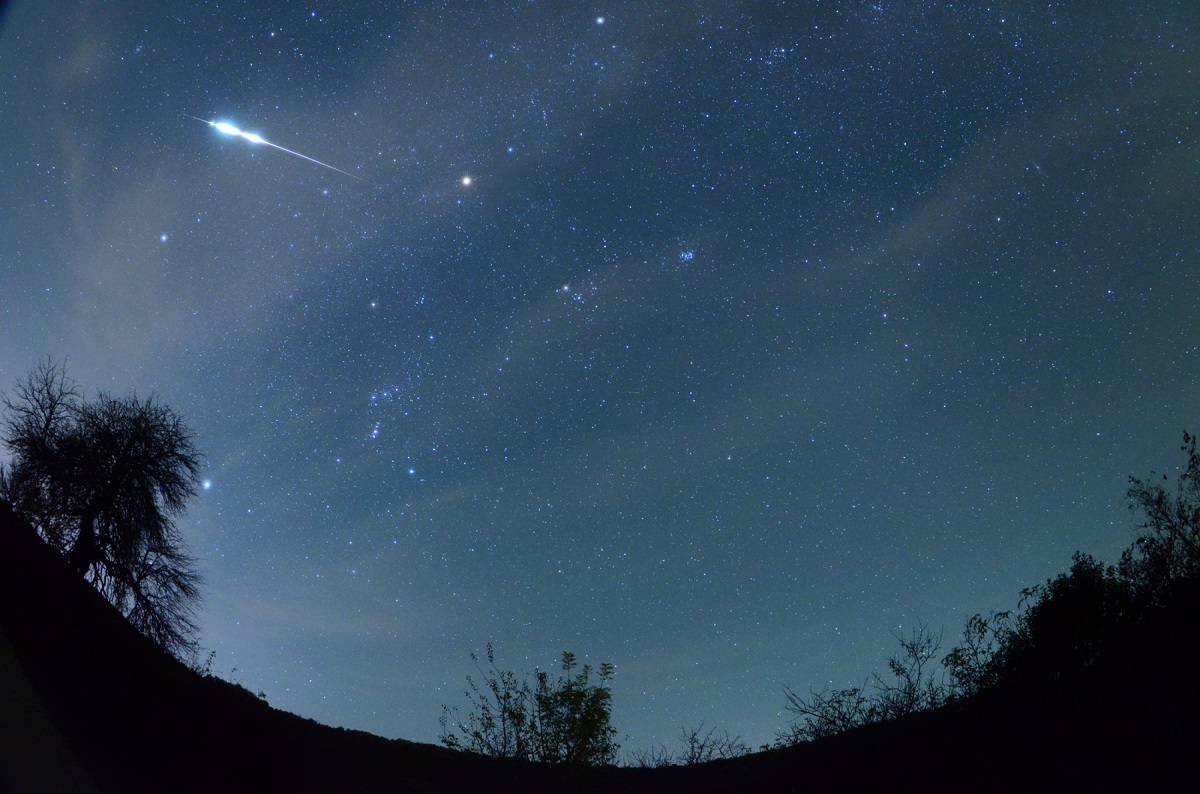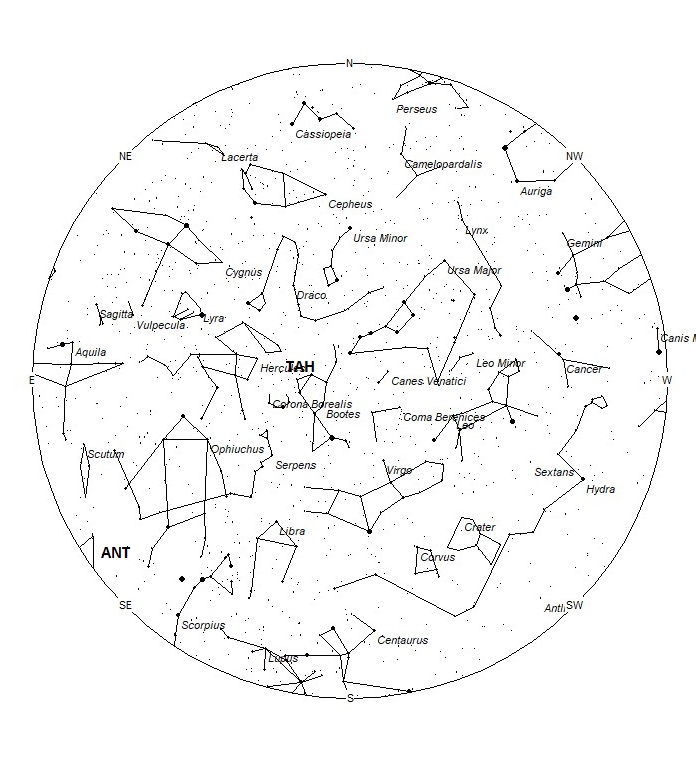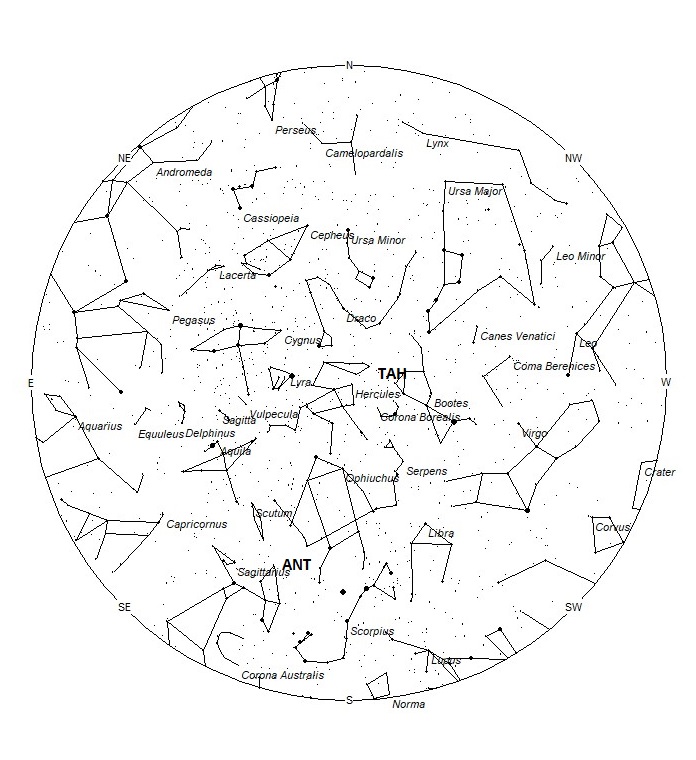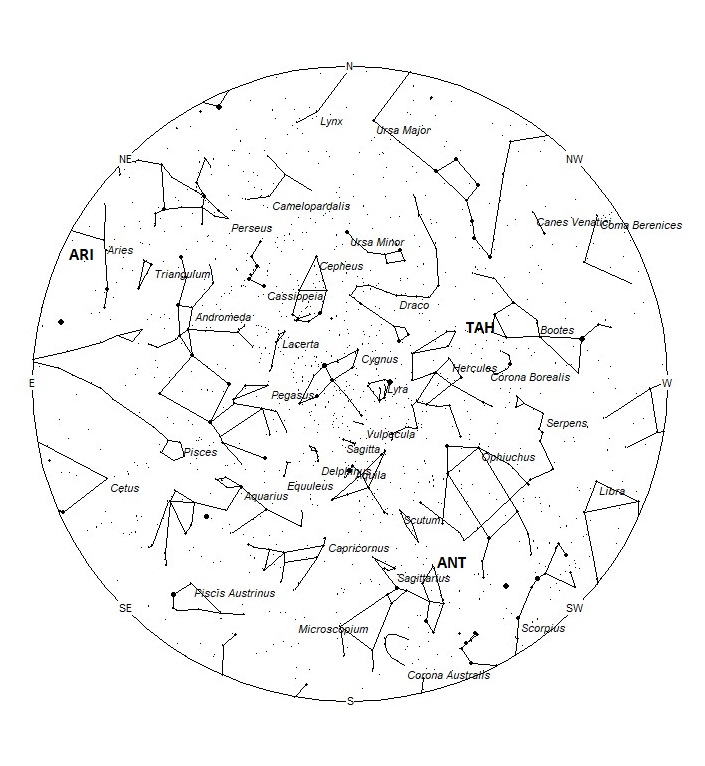 Mónika Landy-Gyebnár captured this multi-bursting South Taurid fireball on October 26, 2022, at 03:43 CEST (1:43 UT) from Hárskút, Hungary. She commented “First it was very bright (-2 magnitudes) and green then quickly faded, still remained visible for 5 minutes, twisted and drifted away, upwards. Then the thin clouds covered it. ©Mónika Landy-Gyebnár
Mónika Landy-Gyebnár captured this multi-bursting South Taurid fireball on October 26, 2022, at 03:43 CEST (1:43 UT) from Hárskút, Hungary. She commented “First it was very bright (-2 magnitudes) and green then quickly faded, still remained visible for 5 minutes, twisted and drifted away, upwards. Then the thin clouds covered it. ©Mónika Landy-GyebnárAs seen from the northern hemisphere, June is another slow month for meteor activity. There are no major showers active in June and only the Anthelion source can be counted on for continuous activity. Sporadic rates continue to remain low as seen from the mid-northern hemisphere (45 N) with only half the rates seen from the mid-southern hemisphere. For the upper half of the northern hemisphere the nights are short to non-existent this time of year. As seen from the southern tropics (25 S) sporadic rates continue to be strong this month with morning hourly rates near 10.
During this period, the moon reaches its full phase on Sunday June 4th. On that date it will lie above the horizon all night long. As the week progresses, the moon rises approximately 45 minutes later each night. Toward the end of this period the evening hours are free of interfering moonlight. Unfortunately, during the evening hours meteor rates are low this time of year. The estimated total hourly rates for evening observers this week should be near 2 as seen from mid-northern latitudes (45N) and 4 as seen from tropical southern locations (25S) For morning observers, the estimated total hourly rates should be near 4 as seen from mid-northern latitudes (45N) and 6 as seen from tropical southern locations (25S). The actual rates seen will also depend on factors such as personal light and motion perception, local weather conditions, alertness, and experience in watching meteor activity. Rates are reduced during this period due to bright moonlight. Note that the hourly rates listed below are estimates as viewed from dark sky sites away from urban light sources. Observers viewing from urban areas will see less activity as only the brighter meteors will be visible from such locations.
The radiant (the area of the sky where meteors appear to shoot from) positions and rates listed below are exact for Saturday night/Sunday morning June 3/4. These positions do not change greatly day to day so the listed coordinates may be used during this entire period. Most star atlases (available at science stores and planetariums) will provide maps with grid lines of the celestial coordinates so that you may find out exactly where these positions are located in the sky. I have also included charts of the sky that display the radiant positions for evening, midnight, and morning. The center of each chart is the sky directly overhead at the appropriate hour. These charts are oriented for facing south but can be used for any direction by rotating the charts to the desired direction. A planisphere or computer planetarium program is also useful in showing the sky at any time of night on any date of the year. Activity from each radiant is best seen when it is positioned highest in the sky, either due north or south along the meridian, depending on your latitude. It must be remembered that meteor activity is rarely seen at its radiant position. Rather they shoot outwards from the radiant, so it is best to center your field of view so that the radiant lies at the edge and not the center. Viewing there will allow you to easily trace the path of each meteor back to the radiant (if it is a shower member) or in another direction if it is sporadic. Meteor activity is not seen from radiants that are located far below the horizon. The positions below are listed in a west to east manner in order of right ascension (celestial longitude). The positions listed first are located further west therefore are accessible earlier in the night while those listed further down the list rise later in the night.
These sources of meteoric activity are expected to be active this week.
.
The tau Herculids (TAH) are an irregular shower not active every year. They are best known for being associated with comet Schwassmann-Wachmann 3 and the strong displays seen in 1930 and 2022. Due to recent activity from the comet, this shower could produce more activity in upcoming years. The radiant is expected to lie near 15:19 (230) +39. This area of the sky is located in northeastern Bootes, 2 degrees northwest of the 4th magnitude star known as Alkalurops (mu1 Bootis). This is not close to the star tau Herculis, for which this shower is named. Apparently, the discoverers of this display placed the radiant further east toward Corona Borealis and Hercules. It’s also possible that past displays from this source had a different radiant area. This area of the sky is best placed near 2300 local daylight-saving time (LDST), when it lies high overhead for observers located in mid-northern latitudes. These meteors are visible from the Southern Hemisphere, but the radiant is located low in the northern sky. Therefore, rates would only be a fraction of what is visible from sites further north. Unlike last year, no exceptional activity is expected from this source in 2023. Rates are not expected to be more than 1 meteor per hour, if that much. With an entry velocity of 15 km/sec., the average tau Herculid meteor would be of very slow velocity.
The center of the large Anthelion (ANT) radiant is currently located at 17:44 (266) -23. This position lies on the Ophiuchus/Sagittarius border, 4 degrees northeast of the 3rd magnitude star known as theta Ophiuchi. Due to the large size of this radiant, Anthelion activity may also appear from western Sagittarius as well as southern Ophiuchus. This radiant is best placed near 0100 LDST, when it lies on the meridian and is located highest in the sky. Rates at this time should be less than 1 per hour as seen from the Northern Hemisphere and 1 per hour as seen from south of the equator. With an entry velocity of 30 km/sec., the average Anthelion meteor would be of slow velocity.
The Daytime Arietids (ARI) are active from May 29-June 17 with maximum activity occurring on June 5th. These meteors are difficult to catch as the radiant only lies 30 degrees west of the sun. Therefore, the only time these meteors are visible is during the last dark hour before dawn. Any member of this shower will be see shooting from low in the eastern sky just prior to dawn. The radiant is currently located at 02:46 (042) +24. This area of the sky is located in northern Aries, 3 degrees southwest of the 4th magnitude star known as Bharani (41Aa Arietis). Current rates are expected to be less than 1 no matter your location. With an entry velocity of 39 km/sec., the average meteor from this source would be of medium velocity. For radio observers, this is the best time of the year to hear meteors. Radio rates will be increasing now and will peak during the second week of June when this shower and the Daytime zeta Perseids reach maximum activity.
As seen from the mid-northern hemisphere (45N) one would expect to see approximately 3 sporadic meteors per hour during the last hour before dawn as seen from rural observing sites. Evening rates would be near 1 per hour. As seen from the tropical southern latitudes (25S), morning rates would be near 5 per hour as seen from rural observing sites and 2 per hour during the evening hours. Locations between these two extremes would see activity between the listed figures. Rates are reduced due to intense moonlight.
You can keep track of the activity of these meteor showers as well as those beyond the limits of visual observing by visiting the NASA Meteor Shower Portal. You can move the sky globe to see different areas of the sky. Colored dots indicate shower meteors while white dots indicate sporadic (random) activity. The large orange disk indicates the position of the sun so little activity will be seen in that area of the sky.
The list below offers the information in tabular form of the showers that I feel are within reach of the visual observer to discern. Hourly rates are often less than 1 but noting parameters such as the radiant distance and the elevation of each meteor, one can compute the probability of shower association. Most showers discovered by video means have rates less than 1 meteor per night away from maximum, so the showers listed in these articles are not as weak as they seem. Rates and positions are exact for Saturday night/Sunday morning except where noted in the shower descriptions.
| SHOWER | DATE OF MAXIMUM ACTIVITY |
CELESTIAL POSITION | ENTRY VELOCITY | CULMINATION | HOURLY RATE | CLASS |
| RA (RA in Deg.) DEC | Km/Sec | Local Daylight-Saving Time | North-South | |||
| tau Herculids (TAH) | Jun 03 | 15:19 (230) +39 | 15 | 23:00 | <1 – <1 | III |
| Anthelion (ANT) | – | 17:44 (266) -23 | 30 | 02:00 | <1 – 1 | II |
| Daytime Arietids (ARI) | Jun 05 | 02:46 (042) +24 | 39 | 11:00 | <1 – <1 | I |
Class Explanation: A scale to group meteor showers by their intensity:
- Class I: the strongest annual showers with Zenith Hourly Rates normally ten or better.
- Class II: reliable minor showers with ZHR’s normally two to ten.
- Class III: showers that do not provide annual activity. These showers are rarely active yet have the potential to produce a major display on occasion.
- Class IV: weak minor showers with ZHR’s rarely exceeding two. The study of these showers is best left to experienced observers who use plotting and angular velocity estimates to determine shower association. These weak showers are also good targets for video and photographic work. Observers with less experience are urged to limit their shower associations to showers with a rating of I to III.
 American Meteor Society
American Meteor Society



I witnessed a very large meteor. June, 3rd, 2023. Maybe 11:30 ? South West of Whitefish, Montana, Meteor was heading North West. Very long, large and bright. It was still bright as it neared the horizon, heading towards Idaho.
I also witnessed a very large fireball like meteor on June 3rd 2023 around the same time! I was at Baker Lake in Washington and it appeared to be heading North West as well!
I witnessed a very large green meteor in the TAU Hercules (TAH) constellation on June 3rd @23:00 (so big I thought it was a plane at first). In Abbotsford, British Columbia. It was headed north. It was very bright as it fell down towards the horizon. Thanks for posting this information. I wanted to verify it.
I witnessed a very large green meteor in the TAU Hercules (TAH) constellation on June 3rd @23:00 (so big I thought it was a plane at first). In Abbotsford, British Columbia. It was headed north. It was very bright as it fell towards the horizon.